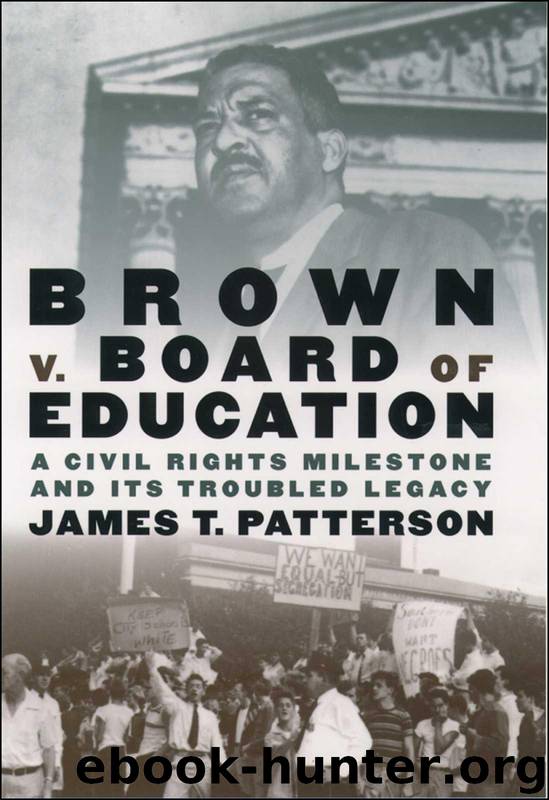Brown v. Board of Education: A Civil Rights Milestone and Its Troubled Legacy (Pivotal Moments in American History) by James T. Patterson

Author:James T. Patterson
Language: eng
Format: mobi
Publisher: Oxford University Press
Published: 2001-03-01T07:00:00+00:00
Most top federal officials, however, remained committed in the late 1960s to desegregation of the schools. This was a high tide of expectations, especially among the rapidly expanding officialdom of Washington, about the capacity of liberal public policy to create a more egalitarian society. Between the mid-1960s, when Johnson and his advisers drove the civil rights acts and the Elementary and Secondary Education Act through Congress, and 1973, when the Supreme Court delivered the last of several strongly voiced opinions that strengthened Brown, all three branches of government broke with the gradualist guidelines of Brown II and moved with unparalleled and sometimes passionately cooperative determination to promote desegregation in schools. The cooperation of the three branches accomplished far more than the Court, since Brown, had been able to accomplish alone.
The first of these actions, the Civil Rights Act of 1964, mainly sought to attack racial segregation in public accommodations and employment. But it also featured a Title VI empowering federal officials to cut off aid from school districts that practiced de jure segregation. The bill passed only after apprehensive congressmen—from the North as well as the South—managed to insert what they thought was a clause that would protect their constituencies against the imposition of racial quotas. “‘Desegregation,’ “the clause read, “shall not mean the assignment of students to public schools in order to overcome racial imbalance.”35 To this extent the Civil Rights Act advanced a color-blind vision of the good society. It sought to promote equal opportunity by ending Jim Crow in the South, not to promote affirmative action or guarantee equal results for blacks either in the North or the South.36
Within the next five years, however, eager liberal officials in the swelling federal bureaucracies established under the auspices of the Great Society were interpreting the law so as to strive for “racial balance”—one of the most controversial phrases concerning school desegregation to emerge from the late 1960s. What the phrase meant was often maddeningly unclear in the details—hence some of the controversy—but its confident supporters relied on three assumptions: heavily black or all-black schools were generally inferior, thus (as the Clarks had argued in 1954) sabotaging the desire for achievement among students who were forced to attend them; low-income black pupils who were enabled to mix with motivated middle-class white students would achieve more; and mixing would promote racial tolerance over time. The goals of enhancing academic achievement and interracial understanding lay at the core of the rising quest for racial balance.
To achieve this balance, school officials practicing de jure segregation were expected to mix the races in rough accordance with the percentages of blacks and whites of school age in their districts. They were also supposed to attain greater balance in the hiring and assignment of teachers, and within classrooms as well as within schools. Moving toward such a standard, ardent liberals in the Department of Health, Education, and Welfare (HEW), which oversaw federal spending for public schools, began pressuring southern school districts as early as December 1964.
Download
This site does not store any files on its server. We only index and link to content provided by other sites. Please contact the content providers to delete copyright contents if any and email us, we'll remove relevant links or contents immediately.
| Africa | Americas |
| Arctic & Antarctica | Asia |
| Australia & Oceania | Europe |
| Middle East | Russia |
| United States | World |
| Ancient Civilizations | Military |
| Historical Study & Educational Resources |
Cat's cradle by Kurt Vonnegut(14773)
Pimp by Iceberg Slim(13792)
Underground: A Human History of the Worlds Beneath Our Feet by Will Hunt(11846)
4 3 2 1: A Novel by Paul Auster(11803)
The Radium Girls by Kate Moore(11632)
Wiseguy by Nicholas Pileggi(5324)
American History Stories, Volume III (Yesterday's Classics) by Pratt Mara L(5139)
Perfect Rhythm by Jae(5080)
The Fire Next Time by James Baldwin(5024)
Paper Towns by Green John(4806)
Pale Blue Dot by Carl Sagan(4627)
A Higher Loyalty: Truth, Lies, and Leadership by James Comey(4559)
The Mayflower and the Pilgrims' New World by Nathaniel Philbrick(4285)
The Doomsday Machine by Daniel Ellsberg(4250)
Killers of the Flower Moon: The Osage Murders and the Birth of the FBI by David Grann(4193)
Too Much and Not the Mood by Durga Chew-Bose(4097)
The Sympathizer by Viet Thanh Nguyen(4096)
The Borden Murders by Sarah Miller(4028)
Sticky Fingers by Joe Hagan(3916)
